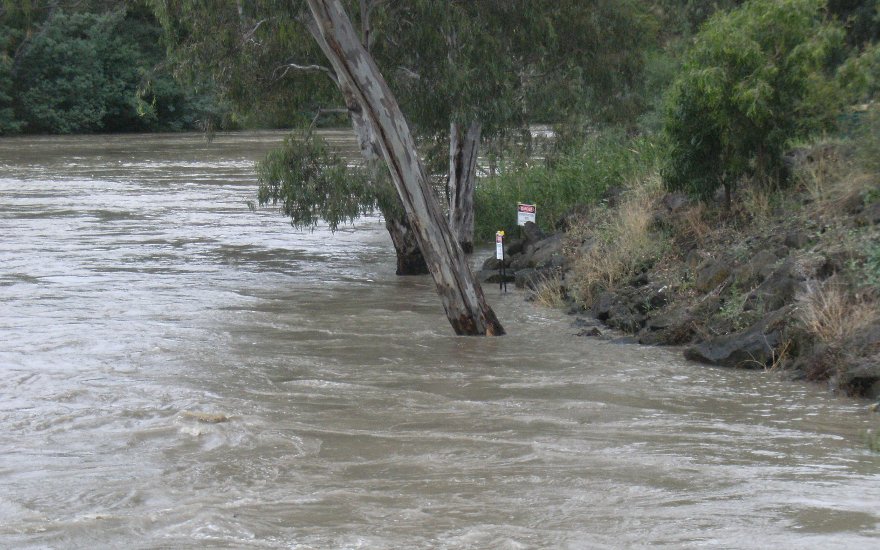Part 1: Drought
On New Year’s Day 2007, drought came to Melbourne. Water restrictions, previously moderate, were tightened, and overnight the residents of Australia’s second largest city found themselves in a water crisis: fountains stopped flowing, gardens went unwatered, and almost immediately the city turned brown. Water still came gushing out of the tap as it always had, but a psychological weight fell over the city, and suddenly the most urgent civic conversations among Melbournians – myself included – were about grey water, and pipelines, and desalination plants. Signs started appearing – on garden fences, on the sides of street-cleaning vehicles – proclaiming that recycled water was being used, and as Melbourne waited for rain the city’s broadsheet daily, the Age, recorded on the front page every morning the steadily dropping levels of the reservoirs that keep Melbourne’s four million residents alive: less than thirty-five percent full; less than thirty percent full; at their nadir, in June 2009, only 25.9% full.
The abruptness with which the drought arrived in Melbourne was an artifice: the city was already in drought, we just didn’t realise it. By the time Stage 3 water restrictions came into force here most of the country had been suffering for years under Australia’s worst drought in a century – perhaps its worst on record. It’s known now, after the fact, as the Millennium Drought; it began as early as 1997 and by 2000 it had spread throughout the south-east, the south-west, and the central east coast: the same areas where the majority of Australians live.
Though inner-city residents like me were for a long time protected from the worst of it, the drought’s devastation was immediately obvious if you travelled into the countryside: if you flew interstate the land below was so dry it looked mummified; if you drove through the bush you’d see that even the Eucalypts, trees that specialise in thriving in the often brutal Australian environment, were dying. By the time I moved to Melbourne in 2004 I’d already seen drought cripple my hometown, Canberra, reducing that green city to a husk. If not for the drought it may have been harder for me to leave; as it was I barely recognised any more the city I’d grown up in, and it no longer felt like home.
Drought is slow but it brings in its train
more immediate terrors.
Drought is not like other natural disasters. It’s not a sudden catastrophe but a slow, grinding weariness; a steadily accumulating despair. Hope is not extinguished overnight in a drought but is gradually crushed, one cloudless day at a time, one rainless storm at a time. As another parched day passes, and another, and another, tensions rise, slowly and inexorably: in March 2007 a Melbourne man had his water supply cut off, reduced to a trickle for forty-eight hours, after a neighbour reported that he was breaching water restrictions; in the same month two Brisbane men were arrested for stealing a water tank as that city prepared for Stage 5 water restrictions. In Sydney in November 2007 a 36-year-old man accused a 66-year-old man – incorrectly – of violating water restrictions, and in the ensuing fight killed him.
Drought is slow but it brings in its train more immediate terrors: in early January 2003 a dry electrical storm moved over the forested southern half of the Australian Capital Territory; a bolt of lightning struck a tree and set it alight, and without rain and fed by a build-up of ash-dry leaf litter the fire spread unchecked until, two weeks later on the 18th January, a strong, hot wind blew it and another fire together and straight into Canberra. I can still remember the black leaves that fell from the sky all day long as the fires devoured the city’s western suburbs; all told, some 500 houses were destroyed in a city of only 310,000 people. Four people were killed, a number both tragic and miraculous.
Almost exactly six years later, on Saturday the 7th February 2009, a heatwave that had brutalised Victoria for a week peaked at 46 degrees Centigrade. The bush north of Melbourne, withered and desiccated, burst into flames – some deliberately lit, some spontaneous. 173 people were killed in the Black Saturday bushfires; whole towns were levelled, their residents left homeless and grieving for their friends and family who had been killed. As people tried to drive out of the flames the metal of their car wheels melted in rivulets into the inferno.
In Melbourne on that day the 100-kilometre-an-hour southerly winds that stoked the flames inland kept the city’s sky strangely clear. Devastation was happening elsewhere – but this time we knew about it. It was all over the news. We all knew friends or colleagues who were directly affected. The drought could no longer be ignored. It wouldn’t break for another three years.
Part II to be published on Tuesday, 3rd December 2013.
Part III to be published on Tuesday, 12th December 2013.

